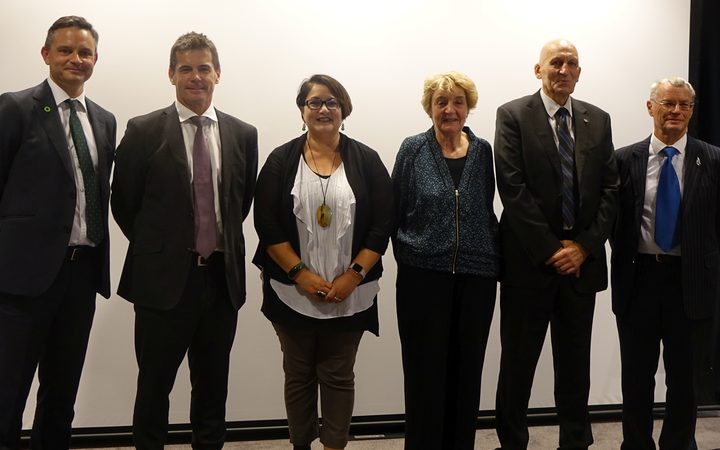The Prime Minister says it is incredibly encouraging that the Climate Change Commission’s first official report shows that reaching our emissions reduction goals are both achievable and affordable.
Prime Minister Jacinda Ardern moves a motion declaring a climate emergency last year. Photo: VNP / Daniela Maoate-Cox
The commission’s first report, published today, laid out a path to drastically reducing greenhouse gas emissions to meet the Paris Agreement targets.
Three new targets for the country were set: an average reduction of 2 percent each year between 2022 and 2025, 17 percent each year between 2025 and 2030 and 36 percent each year between 2030 and 2035.
Commission chair Dr Rod Carr said investing in electric vehicles, renewable energy generation, climate-friendly farming practices and planting more native forests would be critical to meeting the targets.
Prime Minister Jacinda Ardern said the draft advice was incredibly encouraging.
“The commission has determined that the economic cost to New Zealand, as I’ve said, is not as great as previously thought.
“In fact, there are great economic opportunities for new jobs and new business over the coming years as we transition to an emissions free economy.”
However, Ardern said the government would have to address the problem of costs not being distributed evenly across communities.
While the National Party cautiously welcomed the report, it said more analysis was needed.
The party’s climate change spokesperson Stuart Smith questioned whether the proposals were the most cost-effective way of reducing emissions.
He said he would like to see the Emissions Trading Scheme (ETS) get more use.
“Overseas evidence shows that those policies are incredibly cost inefficient and what we have in New Zealand is a very effective ETS, it’s a very well-designed system and what we really need to do is utilise that,” he said.
“That puts a price on emissions, and consumers and businesses will make the decision themselves on how to lower those emissions.”
Climate Minister James Shaw said the release of the draft advice was a significant milestone in the government’s response to the climate emergency.

Climate Change Minister James Shaw (L) with the members of the Climate Change Commission committee, (from left) chair David Prentice, Lisa Tumahai, Dr Jan Wright, Dr Harry Clark and Dr Keith Turner. Photo: RNZ / Benedict Collins
He said the report had significant implications for forestry, with a recommendation to move away from pine forests, often used as carbon credits in the Emissions Trading Scheme.
“They really want to change the way that we think about forestry from a kind of a short-term carbon sink through pine afforestation and rotational forestry into a much greater use of permanent indigenous forestry as a long-term carbon sink for the country as well,” he said.
Professor Troy Baisden, President of the New Zealand Association of Scientists, supported the report’s suggestions but said more detail on agriculture was needed.
“Given that agriculture accounts for nearly half of New Zealand’s current emissions, the report contains relatively little detail on agriculture and land use, except for reductions achieved by forests,” he said.
This reflected the difficulty and uncertainty in achieving emissions reductions in agriculture and projecting them forward, he said.
“The commission’s analysis briefly notes significant yet uncertain areas of potential, such as an ongoing conversion from grazed pastures toward high-value horticulture, such as wine and fruit.
“However, a significant gap is understanding the potential for the growth of a bioenergy sector, and whether this might start to resemble agriculture more than forestry.”
Baisden said this uncertainty around agriculture represented a challenge for the future, that would need to be addressed by new science.
“Getting such science in place will make New Zealand more competitive, and less dependent on the commission’s recommendation to continue buying emissions reductions overseas.
“It will also help project a path forward that will enable innovation throughout our motu, and heed the commission’s prerogative that “‘climate related policies do not further compound historic grievances for Māori.'”
University of Canterbury political scientist Professor Bronwyn Hayward said that while the report showed we weren’t doing our fair share to tackle climate change, there was plenty we could do to improve.
“We can achieve our Paris climate goals at lower costs than we expected and the commission says we can do it with existing technology and we don’t (and shouldn’t) have to plant as many exotic pine forests either.”
She said the rates of change the commission had proposed – reducing emissions by 2 percent net each year to 2025 – were very gentle.
“To put this into perspective, recent research suggests that the country as a whole managed to reduce our emissions by an astonishing 41 percent for the period of our first level four lockdown,” she said.
“We don’t want to put our society on hold for four weeks every year to reduce emissions. But that experience does give us an idea of what the power of collective action could do.”
Draft report’s recommendations
The commission’s advice includes:
- The proposed first three emissions budgets for Aotearoa.
- Recommendations on the direction of the country’s first emissions reduction plan, which provides policy guidance to government on how the emissions budgets could be met.
- A review that finds the first Nationally Determined Contribution (NDC) for Aotearoa is not compatible with the country’s responsibilities under the Paris Agreement to contribute to global efforts to limit warming to 1.5C above pre-industrial levels.
- A consideration of what potential reductions in biogenic methane might be needed by 2100. The result is biogenic methane will need to continue to fall in the second half of this century. This work does not review current targets.
The draft advice is now open for consultation until 14 March and final advice will be released before 31 May.
The government has pledged to release an Emissions Reduction Plan before the end of the year after receiving the final advice, which will set out how the first three emissions budgets will be achieved.
